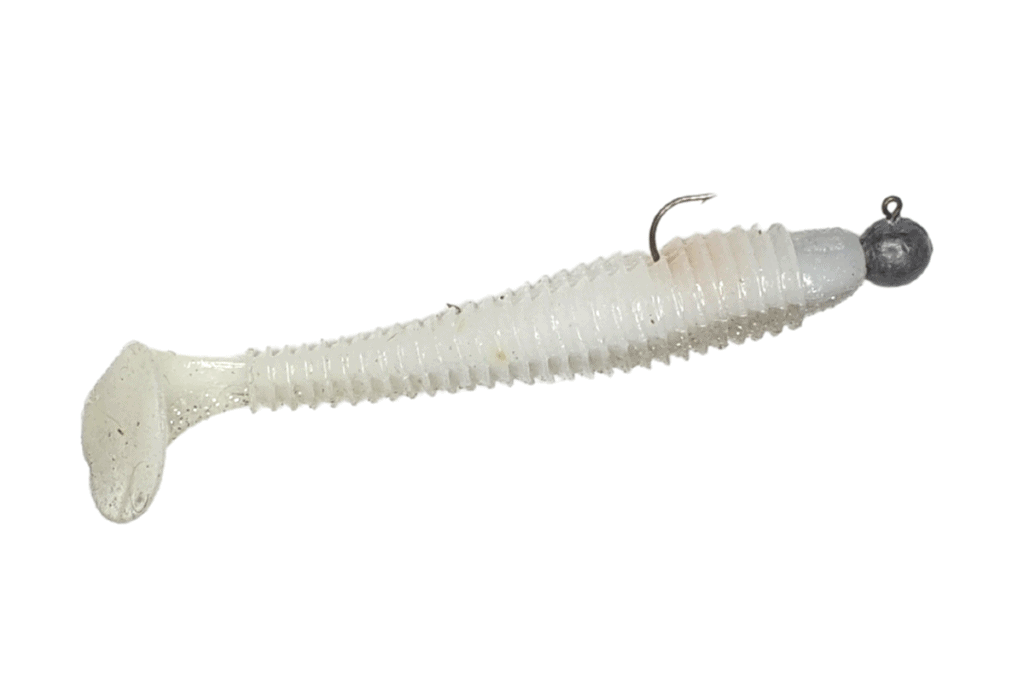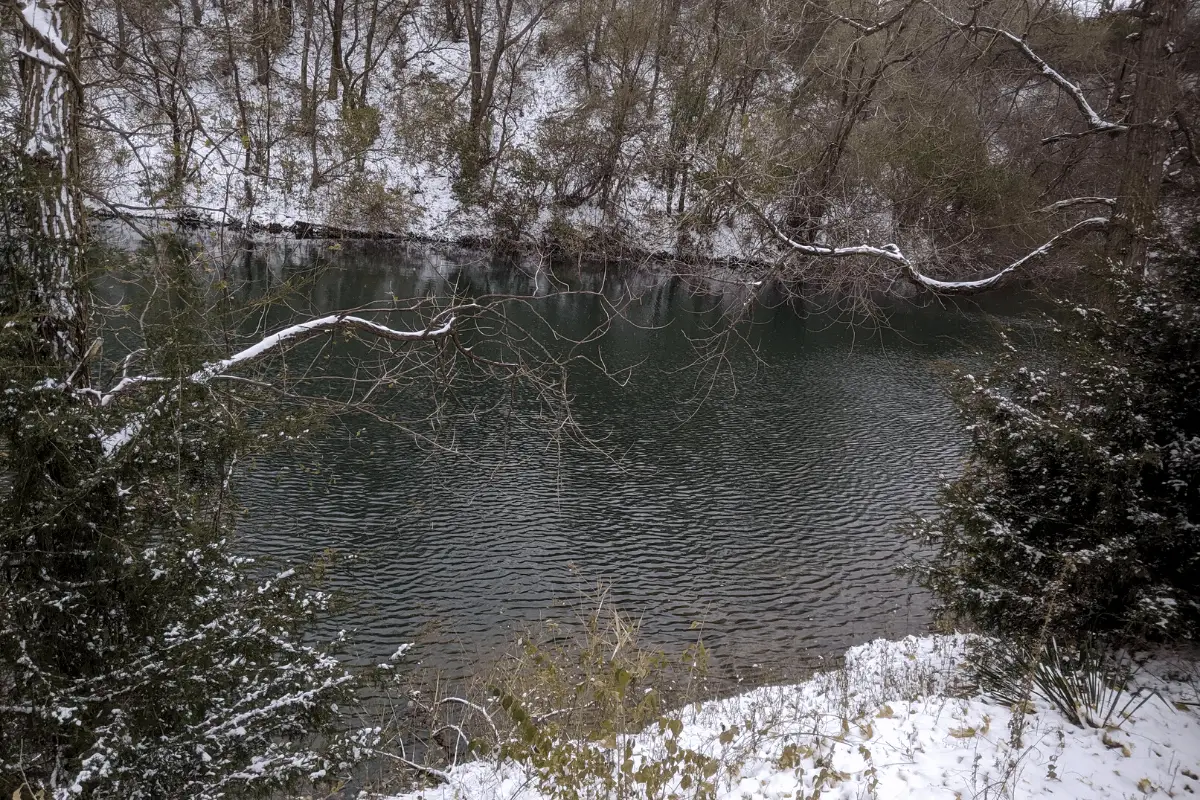There are lots of anglers that just give up fishing when the temperatures turn cold. With the right lure and the right approach, winter bass fishing can be a time of year when you not only have the water to yourself, but the bite can be remarkably good.
A soft plastic swim bait is a terrific choice for winter bass fishing. The versatile lure comes in a variety of sizes and can be fished in all parts of the water column.
When Do You Consider it Winter Bass Fishing?
Winter bass fishing is determined by water temperature, not pages on the calendar. For me, I consider it winter type conditions whenever the red stuff in the thermometer dips below the 50° mark.
At these temperatures, most bass have pulled off the bank and are now hanging out in one of three different areas: on rock, on the bottom in the center of coves and large creeks, or on other types of hard cover such as dock pilings. For more info on where to locate winter bass click on this article.
Winter bass may be sluggish due to being coldblooded creatures, but they still eat and fairly often. The water is usually the clearest it will be all year and the fish are not likely to chase as far, so our lure and presentations need to look as natural as possible.
Lure Choice for Catching Winter Bass
When I fish a swimbait in the winter, I am mimicking baitfish. That will vary depending on the forage you have in your home waters. For many locations, that means threadfin shad or alewives. Other waters may have perch as their primary forage base or even bluegills. Choose a color accordingly, but when in doubt, white or pearl is always a good winter time color choice.
Plastic swimbaits come in a variety of sizes and shapes, but I like to keep it simple. I’ll stick with something in the 3” – 5” range and I always prefer a paddle tail.

When in doubt, think about your selection with this in mind: the bass are going to get a really good look at this lure before deciding to pass or engulf it. The more natural look is always better this time of year. You cannot go wrong if the lure you choose resembles something they might see swimming in the lake or river you are on.
Soft Plastic Swim Baits for Winter Fishing
This is only a partial list
| Manufacturer | Model | Sizes | MSRP |
| Strike King | Rage Swimmer | 2.75”, 3.25” 3.75”, 4.75”, 5.75” | $6.99 |
| Missile Baits | Shockwave | 3.5”, 4.25” | $3.99 |
| Yamamoto | Swimming Senko | 3.5” | $7.49 |
| Zoom | Swimmin’ Super Fluke | 5” | $4.69 |
| Strike King | Swim’n Caffeine Shad | 4”, 5” | $6.99 |
| Zoom | Z-Swim | 3.8” | $4.99 |

Rigging Swim Baits
As mentioned earlier, I am a strong proponent of keeping it simple in the winter. My favorite way to rig a winter swim bait is to use a standard roundball lead head jig with an exposed hook.
I start with a 1/4oz jig head and then adjust from there based on the depth I want to fish, current, and wind speed.
I keep the hook exposed out the back and not embedded in the plastic. Winter bites are subtle. I do not want the hook to fight through any plastic before it gets into the mouth of the bass.
Gear Used for Swimbait Fishing in Winter
My winter swim bait setup is as follows. I like a medium action spinning rod in the 7’ range. I will spool it up with either 6 or 8lb mono. Sometimes I will use fluoro if I want some help with maintaining depth control since fluorocarbon sinks.
Retrieve and Hook Set
This is the easiest part of the entire process. Most of the time I am targeting fish that are belly-down on the bottom. I will cast out my swim bait and let it drop. Once I feel it, or see that the line has stopped sinking, I will slightly twitch the rod to get the tail of the swim bait going. I then use a consistent, steady retrieve to bring the bait back to the boat.
If needed, I will stop my retrieve and let the lure sink back to the lake bed, and then repeat the process. If I am fishing the bottom, I want to keep my lure just above the bass. You may not even see them on your graph because they will be settled in so close to the bottom of the lake they will appear as part of the lake bed structure.
If I am fishing rock, I use a similar retrieve, but I may make contact with the rock once in a while and then let the swim bait deflect off of it.
Other types of hard cover, like dock pilings, are a little trickier to present to. I will throw to the back side of the dock and work the swim bait back and work the bottom first, then I will cast into the same area and work the middle depths. Bass on hard cover like this may suspend higher in the water column, but still press up tight against it.
When setting the hook with this method, use a side sweep – very similar to how you would sweep with a crankbait bite. This is why I like a medium action rod with some give to it. The last thing I want to do is go crazy and rip the lure out of the mouth of the bass. If your hooks are good and sharp, you can also set the hook by reeling down on the fish. These hooksets are not as fun or dramatic as the powerful drive-it-home action you experience in the spring, but holding a nice chunk on a cold winter’s day is fun no matter what.
Types of Water you Fish in Winter
We still need to talk about one area in particular. Winter fishing varies greatly from one body of water to the next. If you fish small rivers and streams, target the deepest pools in those bodies of water. Always, and I mean always, throw upstream and bring your lure back with the current.
If you fish natural lakes, I will look at the deepest water I can locate. On some lakes that may be ten feet, on others in may be sixty. If you are so lucky as to have access to some nice ponds, then you have those winter bass narrowed down. Toss that swim bait into the deepest section of that pond and you are sure to have a good day.
For anglers that live on manmade reservoirs, check the bottom and center of some of the larger coves and creek arms. It is also a smart idea to focus on the deeper side of really long tapering points.
Final Thoughts
There is no doubt about it, to fish in the winter you need to have patience. That is why I like to fish small swim baits this time of year. It keeps you active and casting, but be sure not to start reeling to quickly. Force yourself to reel as slow as you can while still maintaining action with the paddle tail.
If you want to expand your soft plastic lure selection for cold water bass, try a white single tail grub. Anglers in the Ozarks region of the country have been using single tail grubs to trick finicky winter bass for decades. The same rigging, equipment, and presentations apply for this venerable lure as well. Good luck!

